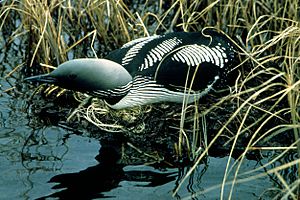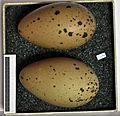Black-throated Loon facts for kids
The Black-throated Loon (Gavia arctica), also known as the Arctic Loon or Arctic Diver, is a beautiful water bird. It is a medium-sized member of the loon or diver family. These birds are known for their amazing diving skills and their striking black and white feathers. They spend most of their lives on water, only coming to land to nest.
Contents
What is a Black-throated Loon?
The Black-throated Loon is a type of water bird found in the northern parts of the world. It is smaller than the well-known Common Loon but larger than the Red-throated Loon. These birds can grow to be about 58 to 73 centimeters (23 to 29 inches) long. Their wingspan can reach up to 130 centimeters (51 inches), which is quite wide! They usually weigh between 1.3 and 3.4 kilograms (2.9 to 7.5 pounds).
How to Spot Them
Adult Black-throated Loons have a very distinct look. They have a grey head and a shiny black throat that can look purple in the sunlight. Their back is black with neat white square patterns, and they have white stripes on their neck and sides. In winter, their colors are less bright, becoming more grey and white. Young loons look similar to winter adults but have a browner back.
Where Black-throated Loons Live
Black-throated Loons live in the northern parts of Europe, Asia, and North America. They prefer to live on large, clear freshwater lakes and ponds during the breeding season. These lakes often have small islands or quiet bays where they can build their nests safely.
Their Favorite Places
You can find them in countries like Russia, Scandinavia (which includes Norway, Sweden, and Finland), and parts of Canada and Alaska. They like areas with open water for fishing and quiet spots for nesting. In winter, they move to coastal waters, usually staying close to the shore.
What Black-throated Loons Eat
These loons are excellent hunters! Their main diet consists of fish. They are very skilled at diving underwater to catch their prey.
Hunting Underwater
Black-throated Loons can dive deep and stay underwater for a long time. They use their strong feet to swim quickly and chase fish. Besides fish, they might also eat small water insects, crustaceans (like crabs or shrimp), and even some plant material, but fish is definitely their favorite meal.
Family Life of Loons
Black-throated Loons usually form pairs and are quite loyal to their nesting sites. They build their nests close to the water's edge, sometimes on small islands or floating platforms of plants.
Nesting and Chicks
The female loon usually lays two eggs, which are olive-brown with dark spots. Both parents take turns sitting on the eggs to keep them warm, a process called incubation. This usually takes about 28 to 32 days. Once the chicks hatch, they are covered in soft, dark down feathers. They can swim and dive almost immediately after hatching! The parents work together to feed and protect their young. The chicks often ride on their parents' backs for safety and warmth.
Amazing Migrations
Like many birds that live in cold northern areas, Black-throated Loons migrate. This means they travel long distances between their breeding grounds and their wintering grounds.
Traveling Far Distances
In the autumn, when the lakes start to freeze, Black-throated Loons fly south to warmer coastal waters. They spend the winter in places like the coasts of Europe, Asia, and North America, where they can find open water and food. In the spring, they fly back north to their breeding lakes to start the cycle all over again. These migrations can cover thousands of kilometers!
Conservation Status
The Black-throated Loon is currently listed as a species of "Least Concern" by conservation organizations. This means their population is generally stable, but like all wildlife, they face some challenges.
Protecting Loons
Threats to loons can include pollution in their habitats, loss of nesting sites due to human activity, and accidental capture in fishing nets. Protecting their freshwater lakes and coastal wintering areas is important to ensure these beautiful birds continue to thrive.
Images for kids
See also
 In Spanish: Colimbo ártico para niños
In Spanish: Colimbo ártico para niños





